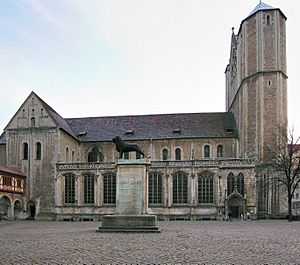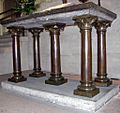Brunswick Cathedral facts for kids
Quick facts for kids Brunswick Cathedral |
|
|---|---|
| Collegiate Church of Saint Blaise and Saint John the Baptist | |
 |
|
| Location | Braunschweig, Lower Saxony, Germany |
| Denomination | Lutheran |
| Previous denomination | Roman Catholic |
| History | |
| Dedication | Saint Blaise, John the Baptist and Thomas Becket |
| Consecrated | 29 December 1226 |
| Architecture | |
| Style | Romanesque |
| Years built | 1173–1195 |
Brunswick Cathedral is a very old and important Lutheran church located in the city of Braunschweig, Germany. It's also known as the Collegiate Church of Saints Blaise and John the Baptist.
In Germany, a large church like this is often called a Dom. This word is similar to the Italian word duomo. Today, the Brunswick Cathedral is used by a group of people who belong to the Lutheran Church in Brunswick.
Contents
History of Brunswick Cathedral
How the Church Started
The Brunswick Cathedral was first started by a powerful ruler named Henry the Lion. He began building it as a special church called a collegiate church between the years 1173 and 1195. A collegiate church is a church that has a group of priests, called canons, who live and work together there.
Inside the church, you can find some very old and important art. One piece is a wooden crucifix made by an artist known as Master Imervard. It was created in the second half of the 1100s. There is also a huge bronze candlestick with seven arms, which is very rare. It was made around the 1170s.
Building Challenges and Dedication
Building the church was not easy. It was stopped several times because Henry the Lion had to leave the country. Because of these delays, Henry the Lion and his wife, Matilda, Duchess of Saxony, were buried in the church even before it was completely finished.
Their limestone statues on their tomb inside the church were made later, between 1230 and 1240. These statues show them in an ideal way, not exactly how they looked. The cathedral was officially opened and dedicated on December 29, 1226. It was dedicated to three saints: Saint Blaise, John the Baptist, and Thomas Becket.
Changes During the Reformation
In 1543, a big change happened in Europe called the Protestant Reformation. The city of Brunswick decided to join the Schmalkaldic League, which supported the new Protestant ideas. This was against the wishes of Duke Henry V. Because of this, Brunswick Cathedral became a Lutheran church. The group of priests who lived there, called the college, was then ended.
The Guelph Treasure
Until 1671, Brunswick Cathedral held a valuable collection of old church items known as the Welfenschatz, or the Guelph Treasure. These items were later moved. In 2015, Germany officially declared 42 pieces of the Guelph Treasure a national treasure.
These special items are now cared for by a foundation called the Stiftung Preußischer Kulturbesitz (SPK). They are displayed at the Bode-Museum in Berlin. The cathedral lost possession of this collection in 1671 when John Frederick, Duke of Brunswick-Lüneburg, took them away.
Notable Burials
Brunswick Cathedral is the final resting place for several important historical figures. One of them is Otto IV, Holy Roman Emperor, who lived from 1175 or 1176 to 1218. Another famous person buried here is Caroline of Brunswick, who was the Queen Consort of George IV of the United Kingdom.
Burials
Many important people are buried in Brunswick Cathedral, including:
- Henry the Lion (1129–1195)
- Matilda of England, Duchess of Saxony (1156–1189), his wife
- Egbert II, Margrave of Meissen (1060–1090)
- Gertrude of Brunswick (1060–1117), his sister
- Otto IV, Holy Roman Emperor (1175/76-1218)
- Empress Beatrice of Hohenstaufen (1198–1212), his wife
- Louis Rudolph, Duke of Brunswick-Lüneburg (1671–1735)
- Princess Christine Louise of Oettingen-Oettingen (1671–1747), his wife
- Ferdinand Albert I, Duke of Brunswick-Lüneburg (1636–1687)
- Ferdinand Albert II, Duke of Brunswick-Lüneburg (1680–1735), his son
- Charles I, Duke of Brunswick-Wolfenbüttel (1713–1780), his son
- Duke Louis Ernest of Brunswick-Lüneburg (1718–1788), his brother
- Duke Ferdinand of Brunswick (1721–1792), his brother
- Charles William Ferdinand, Duke of Brunswick (1735–1806), Charles' I son
- Ferdinand Albert II, Duke of Brunswick-Lüneburg (1680–1735), his son
* Frederick William, Duke of Brunswick-Wolfenbüttel (1771–1815), his son ** William, Duke of Brunswick (1806–1884), his son
- Caroline, Queen of the United Kingdom (Consort of George IV.)
Gallery
-
Martyrdom of Thomas Becket, frescoes in Brunswick Cathedral
See also
- Guelph Treasure












